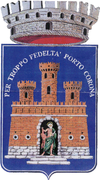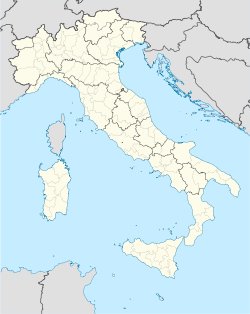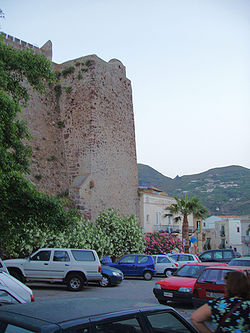- Lipari
-
Lipari — Comune — Comune di Lipari 
Coat of armsLocation of Lipari in Italy Coordinates: 38°28′N 14°57′E / 38.467°N 14.95°E Country Italy Region Sicily Province Messina (ME) Frazioni Alicudi, Filicudi, Panarea, Stromboli, Vulcano, Canneto, Acquacalda, Quattropani, Pianoconte, Lami Castagna Government – Mayor Mariano Bruno Area – Total 37 km2 (14.3 sq mi) Population (30 June 2009) – Total 11,231 – Density 303.5/km2 (786.2/sq mi) Time zone CET (UTC+1) – Summer (DST) CEST (UTC+2) Postal code 98055 Dialing code 090 Patron saint Saint Bartholomew Saint day 24 August Website comunelipari.it Lipari (Sicilian: Lìpari, Latin: Lipara, Ancient Greek: Meligunis) is the largest of the Aeolian Islands in the Tyrrhenian Sea off the north coast of Sicily, and the name of the island's main town. It has a permanent population of 11,231; during the May–September tourist season, its population may reach up to 20,000.
Contents
Geography
Lipari is the largest of a chain of islands in a volcanic archipelago that straddles the gap between Vesuvius and Etna. The island has a surface area of 37.6 km² and is 30 km from Sicily. Besides the main town, most of the year-round population resides in one of the four main villages: Pianoconte is almost due west across the island, Quattropani in the northwest, Acquacalda along the northern coast, and Canneto is on the eastern shore north of Lipari town.
Geology
It is generally accepted that the island was created by a succession of four volcanic movements, the most important of which was the third one, presumably lasting from 20,000 BC to 13,000 BC. A further important phenomenon should have happened around 9000 BC (C14 exams by Keller). The last recorded eruptions occurred in the fifth century CE when the airborne pumice covered Roman villages on the island. The volcanos are considered active, though steaming fumaroles may still be seen and hydrothermal activity. As a result of the volcanic origins, the island is covered with pumice and obsidian. Pumice mining has become a large industry on Lipari, and the pale pumice from Lipari is shipped internationally.
History
Ancient history
Lipari's position has made the harbor of strategic importance. In Neolithic times Lipari was, with Sardinia, one of the few centers of the commerce of obsidian, a hard black volcanic glass prized by Neolithic peoples for the sharp cutting edge it could produce. Lipari's history is rich in incidents as is witnessed by the recent retrievals of several necropolis and other archaeological treasures. Man seems to have inhabited the island already in 5000 BC, though a local legend gives the eponymous name "Liparus" to the leader of a people coming from Campania. Its continuous occupation may have been interrupted violently when the late 9th century Ausonian civilisation site was burned and apparently not rebuilt. Many household objects have been retrieved from the charred stratum.
Greek Colonists from Knidos under Pentathlos arrived at Lipara in 580 BC and settled on the site of the village now known as Castello. The colony successfully fought the Etruscans for control of the Tyrrhenian. Allied with Syracuse at the time of the fateful intervention of Athens in the west in 427, Lipara withstood the assault of Athenians and their allies. Carthaginian forces succeeded in holding the site briefly during their struggles with Dionysios I, tyrant of Syracuse, in 394, but once they were gone the polis entered a three-way alliance which included Dionysios' new colony at Tyndaris. Lipara prospered, but in 304 Agathokles took the town by treachery and is said to have lost pillage from it in a storm at sea. Many objects recovered from wrecks of antiquity are now in the Aeolian Museum at Lipari. Lipara became a Carthaginian naval base during the first Punic War, but fell to Roman forces in 252-251 BC, and again to Agrippa in Octavian's campaign against Pompey. Under the Roman Empire, it was a place of retreat, baths (the hydrothermic waters are still used as a spa) and exile.
From the Middle Ages to present
Lipari was probably an episcopal see from the 3rd century, (first bishop was St. Agatone) and at least from the 6th century the precious relics of St. Bartholomew could be admired in its cathedral.
In the 9th century, Sicily was conquered by the Arabs, and soon Saracen pirates began to raid across the Tyrrhenian Sea, with dramatic effects for Lipari. In 839 the Saracens slaughtered much of the population, the relics of St. Bartholomew were moved to Benevento, and Lipari was eventually almost totally abandoned. The Normans conquered the Arabs throughout Sicily between 1060 and 1090, and repopulated the island once their rule was secure. The Lipari episcopal seat was reinstated in 1131.
Though still plagued by pirate raids, the island was continually populated from this point onward. Rule of the island was passed from the Normans to the Hohenstaufen Kings, followed by the Angevins, and then the Aragonese, until Carlos I, the Aragonese King became the Spanish King, and then quickly was crowned Holy Roman Emperor Charles V.
Franco-Ottoman attack
In 1544, Hayreddin Barbarossa, in conjunction with the French fleet of Captain Polin under a Franco-Ottoman alliance, ransacked Lipari and enslaved the entire population. Jérôme Maurand lamented about the depredation to his Christian coreligionists occasioned by the campaign at Lipari: "To see so many poor Christians, and especially so many little boys and girls [enslaved] caused a very great pity." He also mentioned "the tears, wailings and cries of these poor Lipariotes, the father regarding his son and the mother her daughter... weeping while leaving their own city in order to be brought into slavery by those dogs who seemed like rapacious wolves amidst timid lambs".[1]
A number of the citizens were ransomed in Messina and eventually returned to the islands.
Charles V then had his Spanish subjects repopulate the island and build the massive city walls atop the walls of the ancient Greek acropolis in 1556.
The walls created a mighty fortress which still stands today. The acropolis, high above the main town, was a safe haven for the populace in the event of a raid. While these walls protected the main town, it was not safe to live on the rest of the island until Mediterranean piracy was largely eradicated, which did not truly end until the 19th century.
During Fascism, Lipari Island was a destination for the confinement of members of the political opposition: among them, Emilio Lussu, Carlo Rosselli, Giuseppe Ghetti.
An interesting museum has recently been created to collect a relevant part of local archaeological retrievals; its disparate sections relating to the human history of the entire Aeolian Islands from prehistoric to classical times, also cover vulcanology, marine history, and the paleontology of the western Mediterranean.
Bartolo "Buddy" Valastro Sr., whose son Bartolo "Buddy" Valastro Jr. is the star of the TLC network program Cake Boss, was born and raised in the main town of Lipari on the Island. The Valastro family has a long tradition and history as bakers in Lipari.
See also
References
- Ezio Giunta, dir. (2005). "Lipari". Estateolie 2005*The Essential Guide (English version of Tourist Guidebook): 2–61.
Notes
Sources and external links
- Princeton Encyclopedia of Classical Sites
- Website for Finding Nino Travelogue about living on Lipari, the 2008 winner of the ASTW Travel Book of the Year Award.
 This article incorporates text from a publication now in the public domain: Herbermann, Charles, ed (1913). "Diocese of Patti". Catholic Encyclopedia. Robert Appleton Company. Patti
This article incorporates text from a publication now in the public domain: Herbermann, Charles, ed (1913). "Diocese of Patti". Catholic Encyclopedia. Robert Appleton Company. Patti
Categories:- Cities and towns in Sicily
- Municipalities of the Province of Messina
- Stratovolcanoes
- Aeolian Islands
Wikimedia Foundation. 2010.





